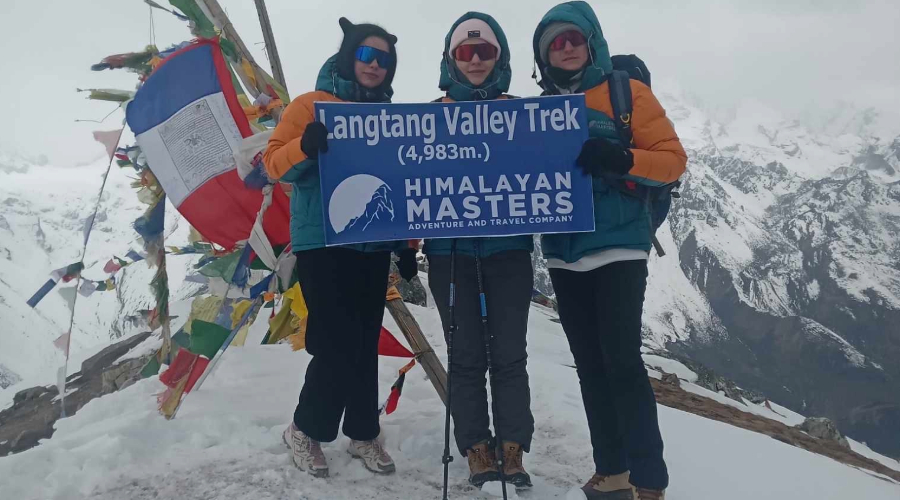
Langtang Valley Trek – 8 Days Itinerary
Langtang, a wonder village in the central north of Nepal, might be your next adventure. The Langtang Valley Trek route is equally popular with foreigners and Nepalese. When the royal family approved it in 1976, the region was protected as Langtang National Park to conserve forests, wildlife, and many other cultural and natural resources.
Recently, it has become one of the most popular trekking decisions after the Everest or Annapurna region. Himalayan Masters arrange a perfect trip in the Langtang region for those who have included Langtang in their bucket list.
The Langtang Treks are a comparatively closer trekking destination than other popular regions. Apart from the Langtang Valley Trek, the Langtang Gosaikunda Trek is also a popular trekking trail.
If you seek a crowd-less trekking route, the Langtang Valley hike, popularly known as the Langtang Trek, can be your best option. This trail falls under the easy-to-moderate trekking route, making it an excellent choice to do as a practice trek before trekking other extensive treks in Nepal.

Compared to the famous Annapurna and Everest treks, this Langtang Valley tour allows you to enjoy solitude and peace. The trails and the accommodation along the pathway are as comfortable as in the Ghorepani Poon Hill trek or the Everest Base Camp trek.
Langtang Valley Trek Facts
- Distance of the trek: 77 km (47.8 miles)
- Trek start/finish point: Syabrubesi (1503 m / 4931 feet)
- Total Ascent: 3925 m
- Total Descent: 3925 m
- Highest Station: Kyanjin Ri (4700 m)
- Permits: TIMS Card/ Langtang National Park entrance permit
- Category: Moderate
- Cost: USD 800
Highlights Of The Langtang Valley Trek
- Scenic drive from Kathmandu to Syabrubesi, which takes 7-8 hours.
- Explore the beautiful Kyanjin village and Kyanjin Gompa and engage in the region’s local culture.
- It is an easy trek that can be done by all levels of trekkers, from beginners to experts.
- 360-degree, astonishing views of the mountains, including Langtang Lirung.
- One of the best sunrise views from the Tserko Ri and Kyanjin Ri viewpoint.
- Walk through beautiful rhododendrons forest and other flora and fauna.
- Visit Buddhist shrines and monasteries and learn about their lifestyle.
- Explore rich biodiversity within the Langtang National Park, including Himalayan Tahr, snow leopards, and red pandas.
- See the mesmerizing views of Langtang Glacier.
- Taste locally produced yak cheese at Kyanjin Gompa Cheese Factory.
- We can extend the tour to the Langtang Helambu region as well as Yala Peak Climbing.
- Stay at beautiful wood-crafted teahouses and experience the Himalayan lifestyle.
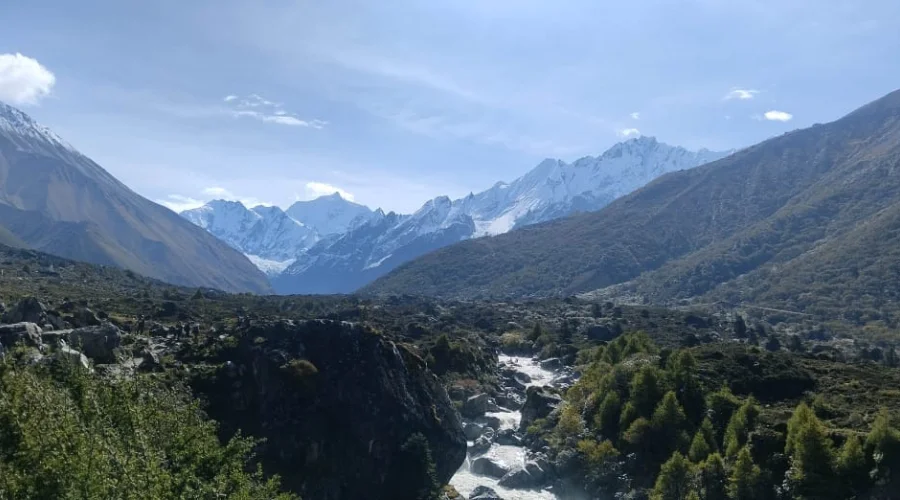
Langtang Valley After the 2015 Earthquake
The 2015 earthquake greatly affected the Langtang trekking region, and your visit might be the chance for the economy to recover. Any expenses you make during your stay in the Langtang Valley now go towards renovating the trekking routes and uplifting the economy in the remote village of Nepal.
Langtang Valley was fully devastated by the earthquake in 2015. More than 200 people died during the earthquake in Langtang. A huge glacier burst caused the avalanche breakdown in the valley. The villagers were gathered at each other’s houses since they had a festival that day. However, due to the earthquake, only one house was left behind, and it was undamaged.
However, the people of Langtang Valley stayed strong after such a strong disaster and united to form a better village. The Langtang Village has now been fully reconstructed. Many aids and donations were made to reconstruct the Langtang Village.
The economy of the valley has also improved since then. The teahouses have been built again with more services and facilities than at the 2015. More teahouses have been added to the valley.

Is it Possible to Hike Langtang Valley Without a guide?
No, one cannot trek to Langtang Valley without a licensed trekking guide. The committee of Langtang National Park has released a notice regarding the compulsion to have a trekking guide during the trek.
On 23rd February 2025, under the Ministry of Forest and Environment, the Langtang National Park released a notice online. The new rules and regulations must be followed. Trekkers must abide by the rules. Not just a normal trekking guide won’t work nowadays. A licensed trekking guide must be with you.
This rule already existed, but few trekkers didn’t follow the guidelines. Many trekkers got lost, and even a few deaths were also noticed due to a lack of a licensed guide with them. Several incidents and accidents have been on the news from the Langtang National Park, so for safety reasons, the department has made a compulsion to have a guide with you.
A licensed guide has knowledge of the routes and paths on the trek. They know the safe as well as the dangerous spots on the trek. This will help to ensure the safety of the trekkers.
Popular Treks in Langtang Region
Himalayan Masters believes in customer satisfaction and safety. We always prioritize the trekker’s needs and wants the way they want. That’s why we help the trekkers customize the Langtang Valley Trek the way they want.
Whether it is a trip add-on, upgrading the accommodation services, transportation, or adding extra days, Himalayan Masters does this all.
Even though we do not have direct packages of customized Langtang Valley Treks, we have made a list of treks in the Langtang region that we can customize per your needs and wants:
- Short Langtang Valley Trek 5 Days
- Langtang Trek 6 Days
- Langtang Valley Trek 7 Days
- Gosainkunda Lake Trek 8 Days
- Tamang Heritage Trek 10 Days
- Langtang Valley with Ganja La Pass Trek 14 Days
- Gosainkunda Pass Trek 12 Days
- Langtang Helambu Trek 6 Days
- Langtang Valley Via Yala Peak Climbing
Can children and senior citizens trek to Langtang Valley?
Everyone from small kids to older citizens can hike to Langtang Valley. Since the trek is not difficult, even a beginner with no experience can easily hike to Langtang Valley. The highest altitude on the trek is above 4500 meters.
So, with proper precautions and safety, one can easily reach the height of Langtang Valley Trek. Also, the Langtang route is not totally steep and uphill, so for senior citizens, it will be easy to trek with the help of trekking poles.
By choosing the optimal season and with the proper guidance of a licensed guide, you can feel a sense of achievement by hiking the Langtang region.
Why Choose Himalayan Masters for Langtang Trek?
- Complimentary airport pick-up and drop-off by private transport.
- Kathmandu to Syabrubesi and back by comfortable private jeep.
- Local experts (All the trek leaders who led the trip to Langtang were born and raised in the Langtang region).
- If needed, an online trip briefing will be held after booking confirmation. The Himalayan Masters will properly brief you about the Langtang Valley trek before departure. You will get a briefing from Sandip, the Himalayan Masters Director or Raj, the adventure expert.
- 100% fixed departure guaranteed.
- Multi-channel communication (Email, WhatsApp, Viber, Telegram, Zoom).
- 24/7 phone communication: +9779823636377 for WhatsApp and +9779851329447 for local and international calls.
- Easy Payment system.
- A complimentary arrangement of Himalayan Masters Brand sleeping bags, down jackets, water bottles, and trekking caps.
- Free excess luggage storage at the Himalayan Masters store during the trek.
- Himalayan Masters-brand waterproof duffle bags will be provided for the porters. (You can take the duffle bags home without needing to return them).
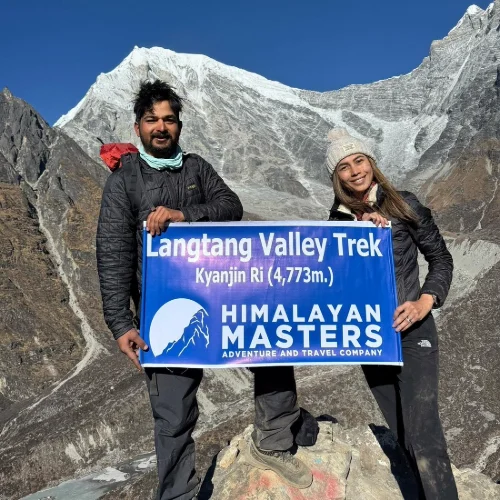
The 8 Days Langtang Valley Trek Itinerary Outline Table
| Day | Itinerary | Distance | Time | Sleep Altitude |
| 01 | Drive to Syabrubesi | 75.8 miles | 7-8 hrs | 1503 m |
| 02 | Trek to Sherpagaon | 6-7 miles | 7-8 hrs | 2563 m |
| 03 | Trek to Langtang Village | 7-9 miles | 7-8 hrs | 3430 m |
| 04 | Trek to Kyanjin Gompa | 3-4 miles | 3-4 hrs | 3870 m |
| 05 | Active Day Hike to Tserko Ri | 4-6 miles | 7-8 hrs | 4983 m |
| 06 | Trek to Lama Hotel | 11 miles | 5-6 hrs | 2470 m |
| 07 | Trek to Syabrubesi | 6.2 miles | 5-6 hrs | 1503 m |
| 08 | Drive back to Kathmandu | 75.8 miles | 7-8 hrs | 1400 m |
Langtang Trek Itinerary Disclaimer
We have a fixed Langtang Valley Trek Itinerary of 8 days. However, due to some unforeseen circumstances, it can fluctuate. Some major factors are weather and climate, health and fitness level and personal needs.
Sometimes, the Langtang trek can take more than 8 days due to bad weather or road conditions. So, one must consider these things when choosing an itinerary. Also, one must note that the trekkers should pay the extra charges for such circumstances.
We, Himalayan Masters, will keep you updated on these kinds of changes from our side. But if you also have to make some new changes, you must inform us beforehand so we can adjust to your needs.
Detailed itinerary
Day 01: Drive from Kathmandu (1400 m) to Syabrubesi (1503 m)
Drive Route: Kathmandu → Trishuli → Dhunche → Syabrubesi
- Beginning Point: Kathmandu (1400 m / 4593 ft.)
- Ending Point: Syabrubesi (1503 m / 4931 ft.)
- Kathmandu to Syabrubesi Distance: 122 km/75.8 miles
- Total Ascent: 103 m
- Lunch: Trishuli Bazaar
- Overnight: Syabrubesi
The trip begins from Kathmandu. After breakfast, Himalayan Masters will pick you up from your hotel and drive to Syabrubesi in a private shared jeep. You will have a wonderful experience driving through Shivapuri National Park.
The zigzag country road, traditional villages, terraced farmland, and fantastic mountain views from the window keep you alert and excited throughout 6 to 7 hours of drive.
Before reaching Syabrubesi, after driving for 3 hours, you will stop at Trishuli Bazar for lunch. From there, you will be passing through Dhunche and reach Syabrubesi.
On the way, you can witness the snow-capped peaks of the Ganesh Himal range. The distance between Kathmandu and Syabrubesi is around 145 km.
About Trishuli Bazar
Trishuli Bazaar, situated at an altitude of 625 meters (2050 ft), is a small town and the headquarters of Nuwakot district. All official governmental works are done here. The town has good facilities for hospitals, restaurants, schools, army barracks, etc. You can find decent guesthouse and hotels too.
About Dhunche
Dhunche, situated at an elevation of 1960 meters (6430 ft), is another small and beautiful village you will encounter on the way. The head office of Langtang National Park is located here.
Dhunche is also the starting point for Langtang Gosaikunda Trek. Here, you can visit a mineral water factory and enjoy the view of the mountains.
About Syabrubesi Village
Situated at an altitude of 1460 meters (4790 ft), Syabrubesi is a small picturesque village on the way to Langtang Valley Trek. The bustling local market of Syabrubesi serves as a gateway to Tibet via the Kerung Highway.
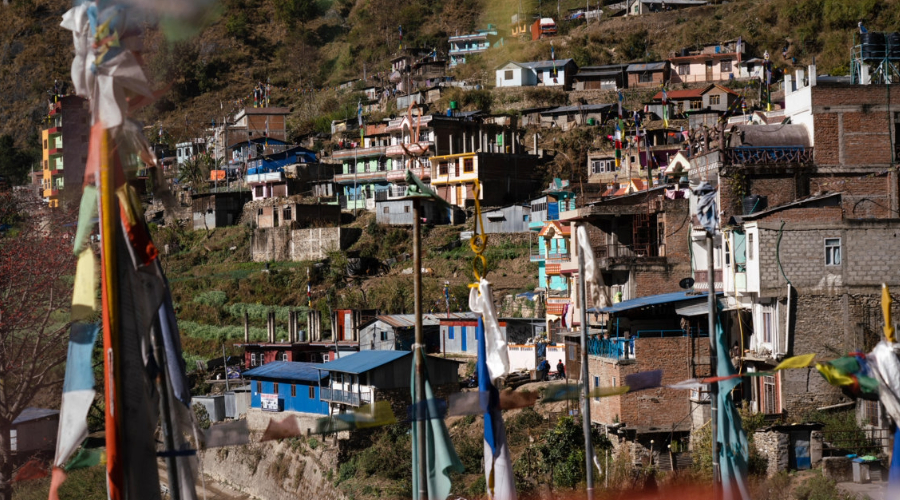
The Syabrubesi village is a starting point for alternative treks in the Langtang region, such as the Tamang Heritage Trail Trek and Langtang Gosaikunda Trek. Likewise, local Tibetan and Tamang gompas are the major highlights of Syabrubesi.
There are about 15-20 decent guesthouses here that provide all the modern facilities like Wi-Fi, hot showers, attached bathrooms, and so on. You can enjoy the local cuisine or order food according to the menu in any guesthouse.
Meal : Breakfast, Lunch & Dinner
Accomodation : Guest House
Walking / Driving : 6 to 7 Hours (Driving)
Day 02: Trek from Syabrubesi (1503 m) to Sherpagaon (2563 m)
Trek Route: Syabrubesi → Khanjim → Sherpagaon
- Beginning Point: Syabrubesi (1503 m)
- End Point: Sherpagaon (2563 m)
- Syabrubesi to Sherpagaon Distance: About 10-12 km
- Total Ascent: 1060 m
- Lunch: Khanjim (2235 m)
- Overnight: Teahouse/Sherpagaon
Major Attractions
- Neat and clean teahouses at Sherpagaon.
- Local traditions and delicacies.
- Local gompas
Challenges
- Long trekking route
- Remote route

After breakfast in Syabrubesi, our trekking starts at around 7 a.m. In the morning, you will trek for about 3 hours, approximately 4-5 km, and then have a short break for lunch at Khanjim. Some trekkers prefer to have lunch at the Lama Hotel. However, the Lama Hotel might be crowded with trekkers going to or returning from the Langtang trek, so the food and other facilities might not be up to the mark.
After having lunch, you will continue our trek to Sherpagaon along the views of the mountain and the stunning Langtang Valley below. It takes about 4 hours to reach Sherpagaon from Khanjim village, covering around 7-8 km.
From Syabrubesi to Sherpagaon, you will cover a total distance of approximately 10-12 km. This route is a deviated route by Himalayan Masters rather than a traditional route that goes through the crowded trail through the Lama Hotel.
About Khanjim Village
Khanjim (2235 m/7332 ft) is a small, beautiful village on the way to our trip. It has around 5-6 teahouses that provide basic food and accommodation facilities. You can also see other 50-60 local houses, including a primary school and local gompas. The majority of the people in this area are engaged in agriculture occupation. Therefore, you can expect to have fresh and healthy locally-grown food here.
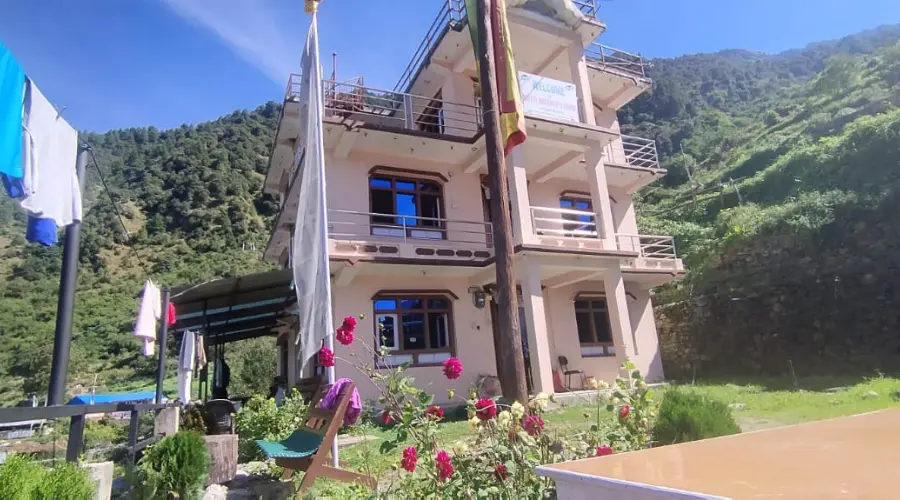
About Sherpagaon
Situated at 2563 meters (8408.79 ft), Sherpagaon is a local Sherpa village where you will stay overnight. There are 5-6 basic teahouses here, providing local food and basic bedding. Apart from these, there are around 10-15 local houses whose residents are engaged in agriculture. They also sell their agricultural products to the Langtang Village.
Meal : Breakfast, Lunch & Dinner
Accomodation : Tea House
Walking / Driving : 7 to 8 Hours (Walking)
Day 03: Trek from Sherpagaon (2563 m) to Langtang Village (3430 m)
Trek Route: Sherpagaon → Riverside Lodge → Ghodatabela → Thyangsyapu → Langtang Village
- Beginning Point: Sherpagaon (2563 m)
- End Point: Langtang Village (3430 m)
- Sherpagaon to Langtang Village Distance: About 12-15 km
- Total Ascent: 867 m
- Lunch: Riverside Lodge
- Overnight: Teahouse/ Langtang Village
Major Attractions
- View the beautiful view of the Langtang range.
- Breathtaking view of Langtang Lirung, one of the highest peaks in the Langtang.
- Explore the Mani stone wall, local gompa, and Tibetan culture.
Challenges
- Long trekking distance and time
- Difficult landscape
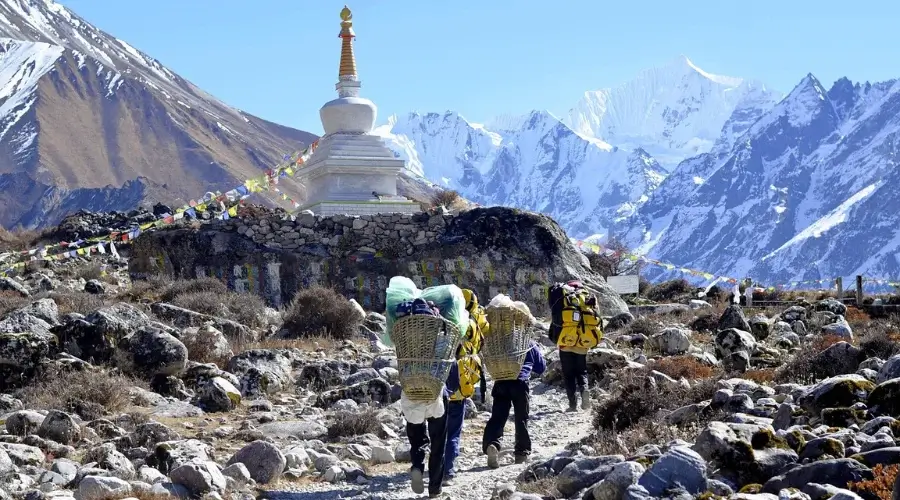
The third day’s trail passes through pine and rhododendron forests and finally enters the broad valley of Langtang. Today, you will witness a few beautiful views of the Langtang Himal range, including Langtang Lirung. After walking for about 4 hours, covering about 8 km, you will stop at Riverside Lodge for lunch at around 11 am.
The trail then moves across alpine meadows, where you will see livestock grazing via Ghodatabela and Thyangsyapu. After an additional four hours, the trail leads you to Langtang Valley/village, where you will stay overnight. This small and beautiful Langtang village was severely damaged in the 2015 earthquake.
About Riverside Lodge
Riverside Lodge is a popular stop point for trekkers on the way from Sherpagaon to Langtang Village. Situated at an altitude of around 2700 meters, only 2 basic teahouses provide local but good food.
About Ghodatabela Village
There are only 2 teashops at Ghodatabela. From its elevation of 2972 meters (9750 ft), you can see an excellent view of Langtang Lirung, the other Langtang Himal range, the Langtang River, and the jungle. It is also the checkpoint to the Langtang National Park.
About Thyangsyapu Village
Thyangsyapu is situated at an elevation of 3140 meters (10,302 ft). There are about 3 to 4 teashops here. From here, you can enjoy the view of Langtang Khola. You might even see Himalayan Thar and different species of birds.
About Langtang Village
Langtang Village is a small and beautiful village at 3430 meters (11,253 ft). Along the way, you can see the Mani stone wall, which showcases the literature of the Tibetan people. The native Tibetan people of the village welcome you with warm hospitality and their Tibetan cuisine. Additionally, you can visit local gompas and an army camp nearby.
Meal : Breakfast, Lunch & Dinner
Accomodation : Tea House
Walking / Driving : 7 to 8 Hours (Walking)
Day 04: Trek from Langtang Village (3430 m) to Kyanjin Gompa (3870 m)
Trek Route: Langtang Village→ Kyanjin Gompa→ Kyanjin Ri→ back to Kyanjin Gompa
- Beginning Point: Langtang Village (3430 m)
- End Point: Kyanjin Gompa (3870 m/12,697 ft)
- Distance: About 5 km
- Total Ascent: 440 m
- Lunch: Kyanjin Gompa
- Overnight: Teahouse/Kyanjin Gompa
Major Attractions
- Excellent view of Langtang Lirung
- Cheese factory
- Historic Kyanjin Gompa, more than 500 years old Buddhist monastery
- Hike to Kyanjin Ri
Challenges
- The temperature in Kyanjing can be quite cold.
- Difficult and steep terrains
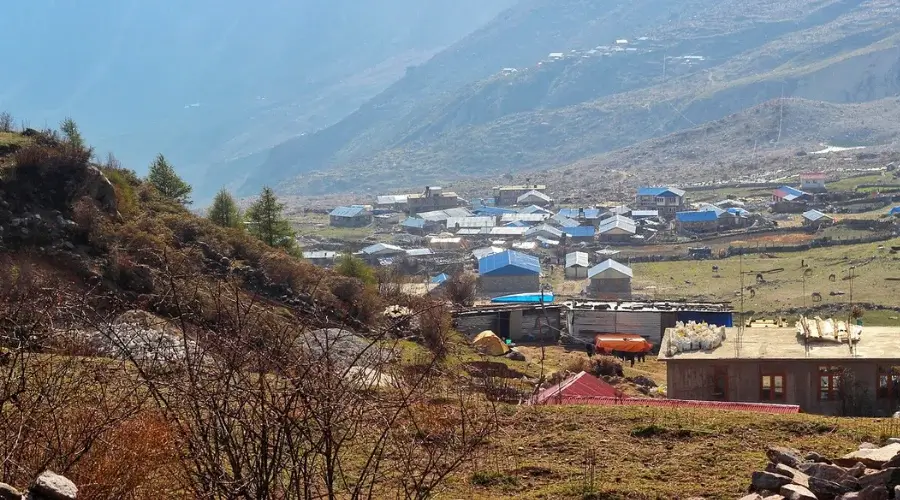
Starting the trek quite early from Langtang village, you must ascend a steep trail, crossing some settlements managed and used by the shepherds. Today, you will be on a short but challenging trek to Kyanjin Gompa, where you will spend the night. It is a 5 km long trek that covers approximately 3-4 hours. Additionally, the trip includes hiking to Kyanjin Ri.
There are no permanent settlements on the way. Thus, the shepherds’ temporary huts are the only options if you decide to spend the night before reaching the Kyanjin Gompa.
About Kyanjin Gompa
After reaching Kyanjin Gompa, you will see the beautiful wall of stones carved with religious scriptures called the Mani stone wall. Thereafter, it is best to spend a few more hours exploring the surrounding areas and acclimatize to the increasing altitude. There are a couple of good teahouses on the way, including about 20-25 teahouses in Kyanjin Gompa, where you can unload your luggage, rest, and hike to Kyanjin Ri.

Kyanjin Gompa is also famous for its cheese factory and views of the rivers, mountain ranges, and glaciers.
About Kyanjin Ri
Hiking to the Kyanjin Ri viewpoint is a short, demanding, yet exciting trek within the Langtang region. The trek covers a total distance of about 3 km and takes about 3 hours to climb uphill and 2 hours to descend downhill. The viewpoint is situated at an elevation of 4773 meters (15,659 ft) and offers a great view of Langtang Lirung mountain, the Langtang Himalayan ranges, and the Langshisa range. It is recommended that you take packed food on the way.

Meal : Breakfast, Lunch & Dinner
Accomodation : Tea House
Walking / Driving : 3 to 4 Hours (Walking)
Day 05: Acclimatization Day | Day Hike to Tserko Ri (4983 m)
Trek Route: Kyanjin Gompa → Tserko Ri → Kyanjin Gompa
- Distance: 7-10 km
- Maximum Elevation: 4983 m (Tserko Ri)
- Total Ascent: 1113 m
- Lunch: Packed lunch
Major Attractions
- Excellent view of Langtang Valley
- Great view of Tibet Himalayan range, Langtang Himal, Langshisa Ri, and Mount Gangchenpo
- Pass through Langtang Ganja-la Pas.
- Reach the highest point of the trip – Tserko Ri (4983 m)
Challenges
- A steep and challenging climb
- Chances of getting altitude sickness
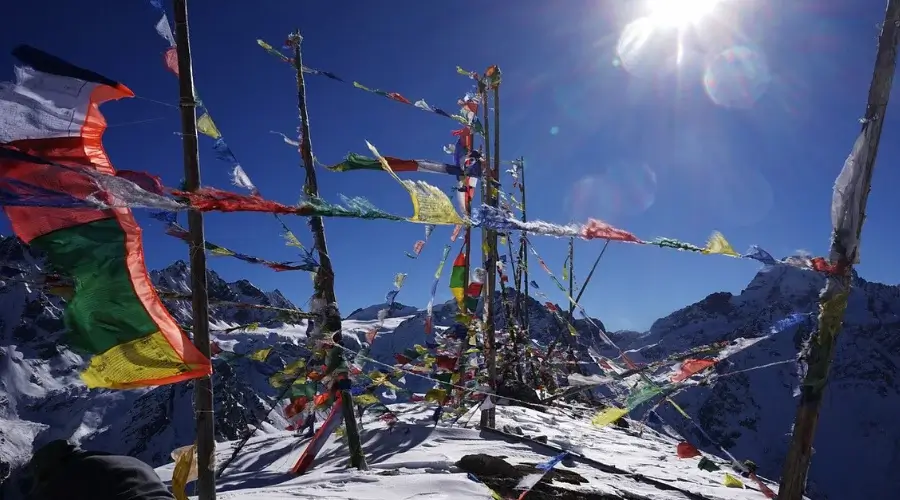
The fifth day of the Langtang Trek itinerary can also be taken as the rest day, as you will spend one more night there. Most trekkers prefer to explore astounding viewpoints not far from the Kyanjin Gompa. There are two staggering viewpoints: Tserko Ri and Kyanjin Ri.
Tserko Ri is one of the most famous and easiest peaks to climb in the Langtang region. Situated at an elevation of 4983 meters (16,348 ft), Tserko Ri Hike covers around 7-10 km. It takes about 5 hours to climb the peak and 3 hours to descend.
From Tserko Ri, you can enjoy breathtaking views of more than 20 peaks, including Langtang Lirung (7234 m). Likewise, you can enjoy the magnificent panoramic view of different mountain ranges from the top of Tserko Ri.
Meal : Breakfast, Lunch & Dinner
Accomodation : Tea House
Walking / Driving : 7 to 8 Hours (Walking)
Day 06: Trek from Kyanjin Gompa (3870 m) to Lama Hotel (2470 m)
Trek Route: Kyanjin Gompa → Langtang Village → Thyangsyapu → Ghodatabela → Lama Hotel
- Beginning Point: Kyanjin Gompa (3870 m)
- End Point: Lama Hotel (2470 m/ 8104 ft)
- Distance: About 18 km
- Total Descent: 1400 m/ 4593 ft
- Lunch: Ghodatabela or Riverside Lodge
- Overnight: Teahouse/ Lama Hotel
Major Attractions
- Alluring Mountain View
- Picturesque Tibetan village
- Lush rhododendron forests
Challenges
- Long descent
- Unpredictable weather
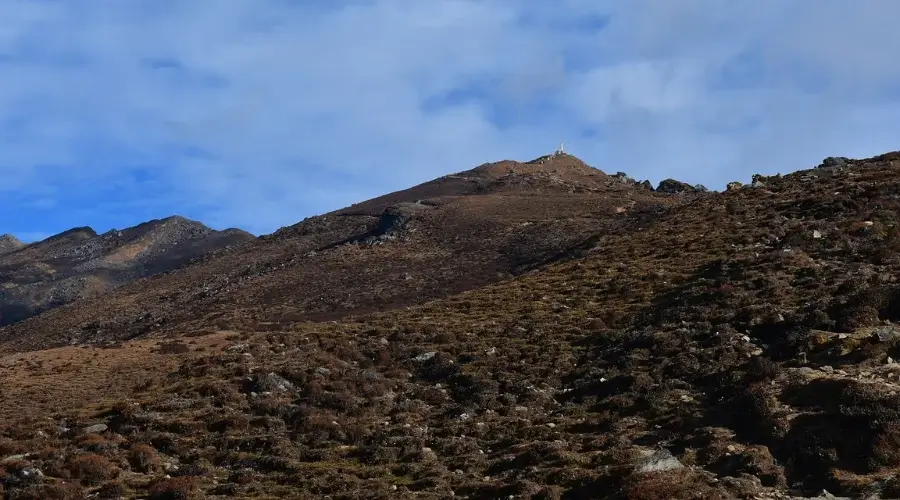
Now, it’s time to return. After enjoying the last breakfast at Kyanjin Gompa, you will head back to Lama Hotel like we did. It is a long walking day but a comfortable descent compared to a steep descent. You will trek via Langtang Village and explore the village more.
After that, you will reach Ghodatabela, where you will have a satiating lunch and finally trek to Lama Hotel. There are about 5-6 teahouses in Lama Hotel. Upon arriving in the village, you will be checked in at one of the fine teahouses for an overnight stay with a fantastic dinner.
Meal : Breakfast, Lunch and Dinner
Accomodation : Tea House
Walking / Driving : 5 to 6 Hours (Walking)
Day 07: Trek From Lama Hotel (2470 m) to Syabrubesi (1460 m)
Trek Route: Lama Hotel → Bamboo → Syabrubesi
- Beginning Point: Lama Hotel (2470 m)
- End Point: Syabrubesi (1460 m)
- Distance: About 10 km
- Total Descent: 1010 m/3314 ft
- Lunch: Bamboo Lodge (1970) or Pahare Hotel
- Overnight: Teahouse/ Syabrubesi
Major Attractions
- Comfortable accommodation in a guesthouse
- Local and foreign foods
- Possibility of alternative side trips
Challenges
- Slippery landscape
- Long and tiring path
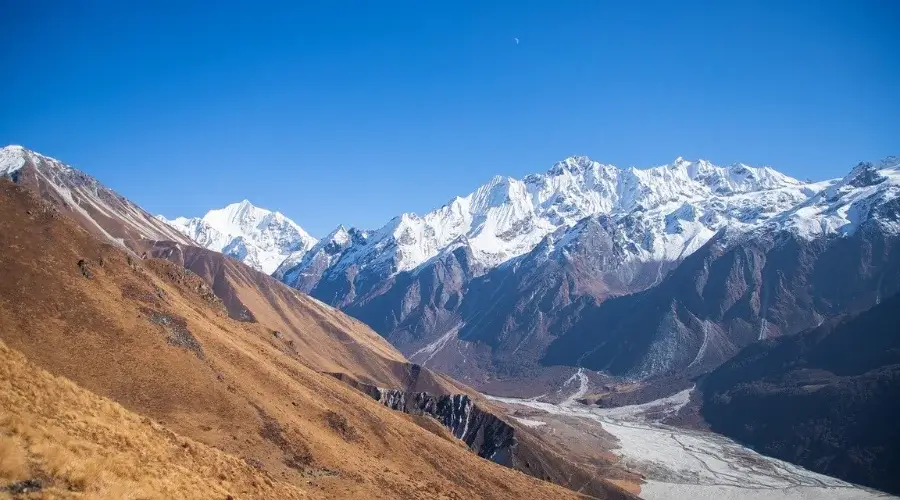
It is the last trekking day. After breakfast at the Langtang region (Lama Hotel), you will begin the trek to Syabrubesi, where you will catch a vehicle to go to Kathmandu. Thus, this is the final trekking day of your trip if you are not trekking to another side of the Langtang region.
The Tamang Heritage and Gosaikunda Lake Trek are the best options to extend your trek. There are two route options to descend back to Syabrubesi from Lama Hotel. The first is the same one you took initially, and the second is much steeper.
This route will offer fabulous views of the Langtang Valley and some tall mountains. Our guide will decide which road to follow depending on the weather and the clients’ stamina.
Meal : Breakfast, Lunch & Dinner
Accomodation : Tea House
Walking / Driving : 5 to 6 Hours (Walking)
Day 08: Drive from Syabrubesi (1460 m) to Kathmandu (1400 m)
Trek Route: Syabrubesi → Dhunche → Trishuli → Kathmandu
- Beginning Point: Syabrubesi (1460 m)
- End Point: Kathmandu (1400 m)
- Distance from Syabrubesi to Kathmandu: 122 km/75.8 miles
- Lunch: Trishuli
- Overnight: 3-Star Hotel/ Kathmandu
Major Attractions
- Comfortable accommodation in a 3-star hotel in Kathmandu
- Explore Kathmandu Valley
After having breakfast at Syabrubesi, you will head to the capital, Kathmandu. A reserved jeep or car by Himalayan Masters will be ready to receive and take you back to Kathmandu. You will be back through the same route, enjoying the beautiful scenery from the window. After 6 to 7 hours of travel, you will arrive in the city, check in at the hotel, and rest.
Note: At least two more days are required before and after the trek, especially for trekkers from countries other than Nepal who want to explore the capital city. So, make sure to have at least 10 days to explore Kathmandu and enjoy the Nepal trip without any haste.
Meal : Breakfast and Lunch
Accomodation : 3-Star Hotel
Walking / Driving : 6 to 7 Hours (Driving)
Include / Exclude
Trip Cost Includes
- International Airport pick-up and drop-off service in a private vehicle
- Kathmandu to Syaprubesi and back to Kathmandu by Comfortable private jeep
- Two nights of basic accommodation in Kathmandu with breakfast
- Seven nights: Best available clean and comfortable Tea house accommodation during the trek
- All meals (breakfast, lunch, and dinner) with tea or coffee during the trek
- Staff insurance and necessary ground transport for support staff
- Guide for eight days
- Trekking permits: Langtang National Park permits and TIMS Card.
- Use a sleeping bag that can withstand -25°C during the trip if needed.
- Use a pulse oximeter to check your spo2 and bpm at high elevations.
- Himalayan Masters brand water bottles and purification tablets.
- First aid kit box.
- Seasonal fruits for dessert.
- The Himalayan Masters Brand Duffle Bag for the Trip (If you hire a porter)
- Himalayan Masters Brand Trekking T-Shirt and Cap
- emergency, one bottle of oxygen.
- All Local and Government taxes and administrative charges
Trip Cost Excludes
- Extra-night accommodation in Kathmandu in case of early arrival or late departure
- Trekking porters
- Lunch and dinner in Kathmandu
- Nepal Visa fee
- Travel and medical insurance
- International flights
- Excess baggage fee
- Personal trekking gear and equipment
- Tips for guide (tipping is expected)
Useful Info
Langtang Valley Trek Difficulty
The Langtang Valley Trek difficulty is classified as moderate by difficulty level. Although it is comparatively tricky, it is hard for most individuals, especially those with average workouts.
This includes daily hikes of approximately 6 to 7 hours with possible elevation gain that causes altitude sickness, especially above 2500 meters. Fitness, training, and acclimatization are other essential aspects that should always be observed for a successful trek.
Trip Grade: Medical fitness level and health
No serious fitness level is needed for the Langtang Valley Trek, but a fairly good one is desirable. In this case, cardiovascular and strength training for at least three weeks before the trek is preferable.
A medical check-up is also needed, as some people may have health problems that can be worsened by walking. Effectively managing health during the trek will be possible if care is taken to improve hydration levels and eat the right diet.
Altitude Sickness in Langtang Valley Trek
During the Langtang Valley Trek, the treks may go as high as 5000 meters, which increases the risk of altitude sickness. Some conditions that manifest due to a lack of oxygen include headache, nausea, fatigue, and shortness of breath.
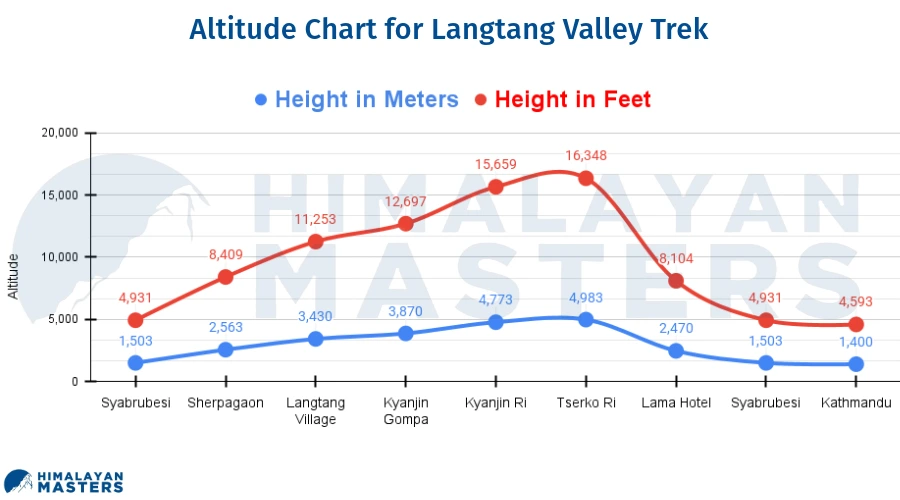
To avoid altitude sickness, one should start ascending gradually and take rest days in between. If signs do not resolve or aggravate, their operation must reduce the flight’s altitude.
Langtang Valley Trek Experience
Although the Langtang Valley Trek is easy, some trekking experiences are always desirable. It involves crossing rugged terrains and slopes, parts of which may be pretty steep at times and thus require very rigorous hiking.

But if you make some physical preparation and go on this trip under the guidance of a professional trekking leader, even those who have never trekked before can successfully complete the Langtang Valley Trek.
Emergency and Evacuation
This is self-explanatory, as everybody needs to be prepared during a medical emergency or other situations en route during the trek. Rescue equipment should be quickly accessible by trek operators, and there ought to be a communication system to alert the rescue team if needed.
Trekkers should also ensure they get the right travel health insurance to cover them in a medical emergency or evacuation.
Packing List for Langtang Valley Trek
Appropriate clothing and other items are essential for trekking to be comfortable and safe. Trekkers should wear warm, waterproof, and windproof layers and appropriate footwear, including boots.
Walking poles and a good-quality backpack should also be taken. Other items include a headlight, water flask, sunblock, and any other medication that may be required.
It must carry as little as possible while ensuring all the needed articles are packed.
Is Special Training Needed?
No training is needed for the Langtang Valley Trek; however, it would still be wise to complete some paperwork before the trek. Such exercises can range from those that affect cardiovascular endurance to muscle building for legs and the tummy to those that help one master breathing at high altitudes.
Best Time for Langtang Valley Trek
The best times to trek in the Langtang Valley are from March to May and September to November. It is warm, mostly with clear skies during the day and relatively cold during the night.
The wettest period is June to August, characterized by occasional flooding and frequent landslides, while December, January, and February remain very cold with occasional snow.

Langtang Valley Trek Permits
You need a Langtang National Park Entry Permit and a TIMS (Trekkers’ Information Management System) card for the Langtang Valley trek.
These Langtang permits can be arranged and bought in Kathmandu or Syabrubesi, where the trekking starts. This is a good reason you must ensure that all the permits required for the trek have been obtained.
Food & Accommodation During Trek
During the Langtang Valley Trek, lodging and food facilities range from Teahouses to camping. Teahouses offer more basic sleeping with meals, while camping brings more freedom and privacy.
The food taken during the trek is Nepali-type, mainly meals and mostly items obtained from Nepal. Different cuisines prefer vegetarian food, and the meals that can be catered for such accommodation can be arranged in advance.
Electricity and Water Facilities
However, most teahouses around the Langtang Valley Trek provide electricity and battery recharging facilities. Carrying a power bank or extra batteries is advised because electricity at higher altitudes may be better.
Fresh drinking water is readily available from springs and streams. However, it must be treated or purified before consumption to eliminate waterborne diseases.
Roads on the Trek & How to Avoid Them
The Langtang Valley Trek passes through distinct tracks for trekking and a few junctions with roads. But recently, some new roads have been built in the area, affecting trekking to some extent.
These roads should, therefore, not be taken. Instead, the advice of your trek leader or guide is advisable since they will have knowledge of the current conditions of the roads and may advise on the best roads to avoid and which ones to take.
Alternative Routes of Langtang Valley Trek
Though basic forms of trekking, such as the standard Langtang Valley Trek, are established, there is more than one option in the region.
The Gosainkunda Lake Trek takes the trekkers on one of the famous pilgrimages for Hindus and Buddhists, Gosaikunda Lake. The trek goes through the rugged terrain, offering a serene spiritual experience.
At the same time, the Helambu Trek is relatively more concerned with the country’s cultural aspects. You can explore lush forests, traditional Tamang villages, and stunning panoramas.
Likewise, another alternative trek route is the trek to Tamang Heritage, which takes you to the picturesque Tamang village. You can explore the cultural village of Thuman, which is known for its rich Tamang culture. This trek is perfect for those looking for cultural immersion along with natural diversity.

Why Choose Himalayan Masters?
As soon as you book our trip package or even while you are planning your trip, the Himalayan Masters team will be there to assist you. You can contact us through email or WhatsApp anytime with general inquiries or questions regarding the trek.
Booking and Airport Pickup
Himalayan Masters is dedicated to your safety and convenient trekking experience. We provide the best trekking itinerary at the most affordable price. Additionally, you can adjust the itinerary according to your preference, comfort, and fitness level. Likewise, we provide an airport pickup and drop-off service.
Support Team
Our support team is ready to offer any help 24/7. Our experienced guides and porters will always be there to accompany you from the start to the end of the Langtang Valley Trek.
Our professionals are well-known for the route, terrain, weather, and local village and are committed to ensuring a fun and successful journey.
Starting and Ending Point
Your Langtang Valley Trek with Himalayan Masters starts and ends at Kathmandu. Likewise, the trekking ends at Syabrubesi on the 7th day of the trip. Finally, on the 8th day, with the drive from Syabrubesi to Kathmandu, your journey ends at Kathmandu.
What does a day on the Langtang Valley Trek look like?
Our typical Himalayan Langtang Valley Trek Itinerary includes five days of trekking, two days in a hotel, and one rest day at Kyanjin Gompa. Each day is a new challenge and exciting experience. Our trip begins with the drive from Kathmandu to Syabrubesi. On the 2nd day only, our trek starts.
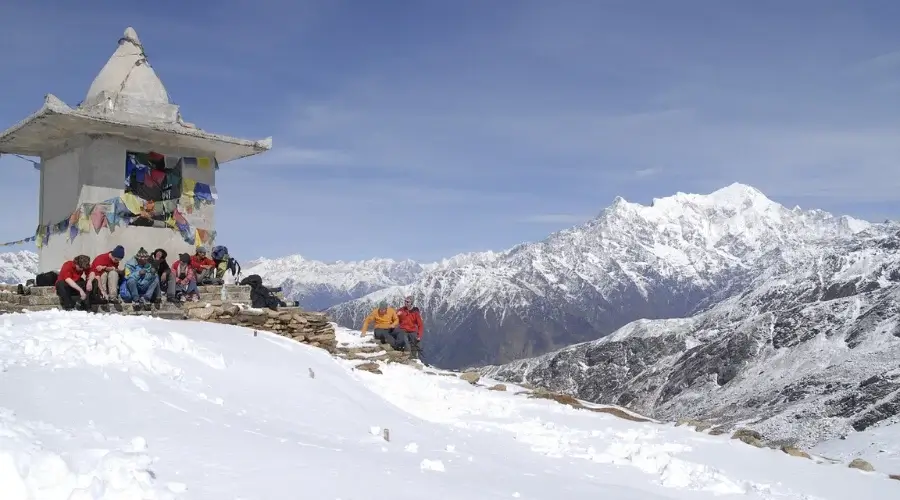
Generally, our trek day starts with a beautiful morning view of the mountains from around 6 a.m. to 7 a.m. Then, you will have a delicious breakfast, which can be ordered on the previous day’s evening.
After having breakfast, at around 9 o’clock, you will get ready and set out for the next destination point, where you will spend overnight.
The guide will suggest one of the teahouses for lunch from 11 a.m. to 12 p.m. You can always choose any teahouse on the way whenever you feel like.
You can also select food from the menu, but we suggest Dal Bhat. Usually, it takes about an hour for the food to be prepared. Meanwhile, you can either catch your breath or stroll around the teahouse.
Finally, after a rejuvenating lunch, you will reach your destination at around 4 p.m. There, you can order your dinner and rest again or visit any tourist sites nearby the village.
Lastly, with a refreshing dinner, you can gather around the fire, share your trekking experience with other trekkers, and sleep around 10 p.m.
Langtang Valley Trek Cost
The cost of Langtang Valley Trek is 800 USD per person, which covers significant needs in the trekking activities, including permits, meals, accommodations, and professional trek leaders, when going to Langtang Valley Trek.
However, this price can fluctuate depending on the agency chosen, the number of people in the group, and other services required.
Please check Langtang Trek’s cost article for a more detailed cost breakdown.
Insurance for Langtang Valley Trek
Therefore, when planning the Langtang Valley Trek, trekkers must purchase travel insurance to be prepared for events like trip cancellations, medical complications or emergencies, and evacuation.
It is important to note that most trekking agencies insist that trekkers carry insurance that allows them to trek at high altitudes. The key to opting for this is to carefully read the policy to ascertain whether it will enable trekking-related activities, such as a helicopter pickup if required.
Additional Expenses
These can include food and beverages, tips, and shopping for products; other than this, it can consist of services like town and city guided tours and cultural activities. They also recommend one budget for tipping guides and porters in Nepal since it is expected. Other possible expenses include:
- Take a shower with hot water.
- Using an Internet connection.
- Charging all sorts of gadgets and appliances since these costs may be higher in the wilderness.
This way, trekkers can plan for other expenditures that need to be incurred during the trek and not have to worry about their finances.
ATMs on Langtang Valley Trek
The Langtang region has very few ATM facilities, and the best chance of using an ATM is at Syabrubesi, the beginning point of the trek. It is suggested that trekkers carry enough cash with them before the trek as there may be no facilities such as an ATM. Teahouses and most shops do not accept credit or debit cards.
FAQs
Can I go camping in Langtang Valley trek?
Langtang is a popular trekking route in Nepal, offering comfortable hotels and teahouses, so there is no need to stay in camp. If you prefer camping, that can be arranged, but it will be more expensive due to the need for extra equipment and additional porters.
What foods are available in Langtang trek?
Is there any ATM on the Langtang Valley trekking route?
Once you leave Kathmandu, the only place where an ATM is available is at Syabrubesi. After that, it’s unlikely that you will find an ATM or online payment service on the way, so it is advised that you carry enough cash for the Langtang trek price before going to Langtang.
What animals are found in Langtang National Park?
Langtang National Park is a rich playground for an extensive number of animals, including mountain mammals such as the Himalayan tahr, black bear, and musk deer. There are also many red pandas, snow leopards, goral, and more. This area is also known for the rear bird species—up to 250 species of birds.
What does Langtang Village look like today?
Langtang Valley has been recovering after being affected by the 2015 earthquake. The teahouses were built new, strong, and better but preserved their traditional essence, and the routes were well-marked and improved after the earthquake.
Have they rebuilt Langtang Valley?
Yes, the reconstruction of Langtang Valley is almost complete now. Many old houses have been left, and new houses have been built along the villages. Due to the new construction, Langtang’s tea houses improved even after the earthquake.
Can you visit Langtang Valley trekking?
Yes, anyone with sound physical health and determination can visit Langtang Valley. The trek to Langtang Valley is among the most leisurely treks in Nepal, and as long as you have a valid passport, the permit for this trek is easily accessible for everyone.
What is the religion of the Langtang village?
The Langtang region is dominantly inhabited by the Tamang people and some settlements of Gurung, Rai, Limbu, and Sherpa in this area, who originated from Tibet and follow Buddhism.
How high is Langtang Trek Nepal?
The highest point of the Langtang Valley trek is 3830 meters (12,697 ft) at Kyanging Gompa. But you can hike to other viewpoints that can go up to 4983 meters at Tserko Ri and 4773 meters (15,659 ft).
Do Nepalese need a permit for trekking to Langtang.
Nepalese just need to pay the Langtang National Park permit fee of NRP 100 to enter Langtang National Park.
When is best time to trek Langtang?
Autumn (September to November) and spring (March to May) are the best times to trek Langtang when the largest number of tourists visit the area. However, being quite low-altitude and close to Kathmandu, trekking during the off-season is also possible in the Langtang Valley.
How much does the Langtang trek cost for Indians?
The Langtang trek cost for Indians is comparatively cheaper than for foreigners as the permit and transportation costs are a bit cheaper, and they can hike without a guide and porter since Nepalese are vaguely familiar with the Indian language. While the rate for rooms and food is the same for India.
Is the Langtang trek worth it?
Yes, trekking to Langtang Valley is absolutely worth it. This is the shortest, cheapest, most accessible trek option from Kathmandu and one of the best treks in Nepal offering a vibrant cultural experience and awesome views.
Can you trek to Langtang without a guide?
No, after a recent update from the Nepal government, hiring a guide for all high mountain treks, including the Langtang Trek, is compulsory. This means you need to find a licensed guide before you get the permits for the Langtang trek, and this guide costs about $20–$25 each day.
Is travel insurance for Langtang trek compulsory?
While having travel insurance for the booking of Langtang trek packages is not compulsory, we recommend that you have one that covers high-altitude rescues, some medical bills, and trip cancellations.
We Himalayan Masters recommend the few insurances we have shared below.
- USA and Canada: Tugo, United Health Care, World Nomad, Blue Cross, and GEO Blue Travel Insurance
- Australia and New Zealand: Fast Cover, Allianz Australia
- Singapore and Indonesia: Ergo, World Nomad (Explore plan level 3)
- Europe: Europe Assistance, Austrian Alpine Club, Allianz Europe
Is Langtang Valley trek safe for solo travelers?
Yes, Nepal is among the safest travel destinations for foreigners, and a Langtang solo trek is possible. However, the trek route passes through the forest and very sparse villages, so it’s suggested that we hire a guide for solo (solo female) trekkers.
How difficult is the Langtang Valley trek?
Langtang today is graded “easy to moderate”. Since the Langtang trek route is among the easiest treks in Nepal, the Langtang trek can be done by any newbie with good physical fitness and no prior trekking experience.
What are the festivals celebrated in Langtang region?
While the major festival celebrated in the Langtang region is Lhosar in February, as per the lunar calendar, they also celebrate Dashain, Tihar, and Chhat during autumn and festivals like Shivaratri and Holi, which fall in spring.
How to extend the trip in Nepal?
The Langtang Valley Trek is a week-long journey, but if you wish to extend your trip in Nepal, you can contact us, and we will arrange a helicopter tour to Everest Base Camp, an elephant safari in Chitwan, a city tour in Pokhara, a visit to Lumbini, or a cultural exploration in Kathmandu Valley. You can also trek to Nagarkot or enjoy adventures like rafting and paragliding.
How to charge your phones in Langtang Valley?
Most of the electricity in the Langtang Valley is generated from solar energy. All the solar panels must be carried and set up, so charging plugs in the room are not kept to save electricity consumption. So, it is advised that you carry a power bank with a good backup, or you will have to charge your phones at the reception with an additional charge.
Is there internet at Langtang Trek?
There is Wi-Fi in some teahouses in Langtang along the way (when the weather is good). Alternatively, you can buy a local SIM card and use the mobile data to contact your family and friends. We can provide you with a local SIM card if necessary.